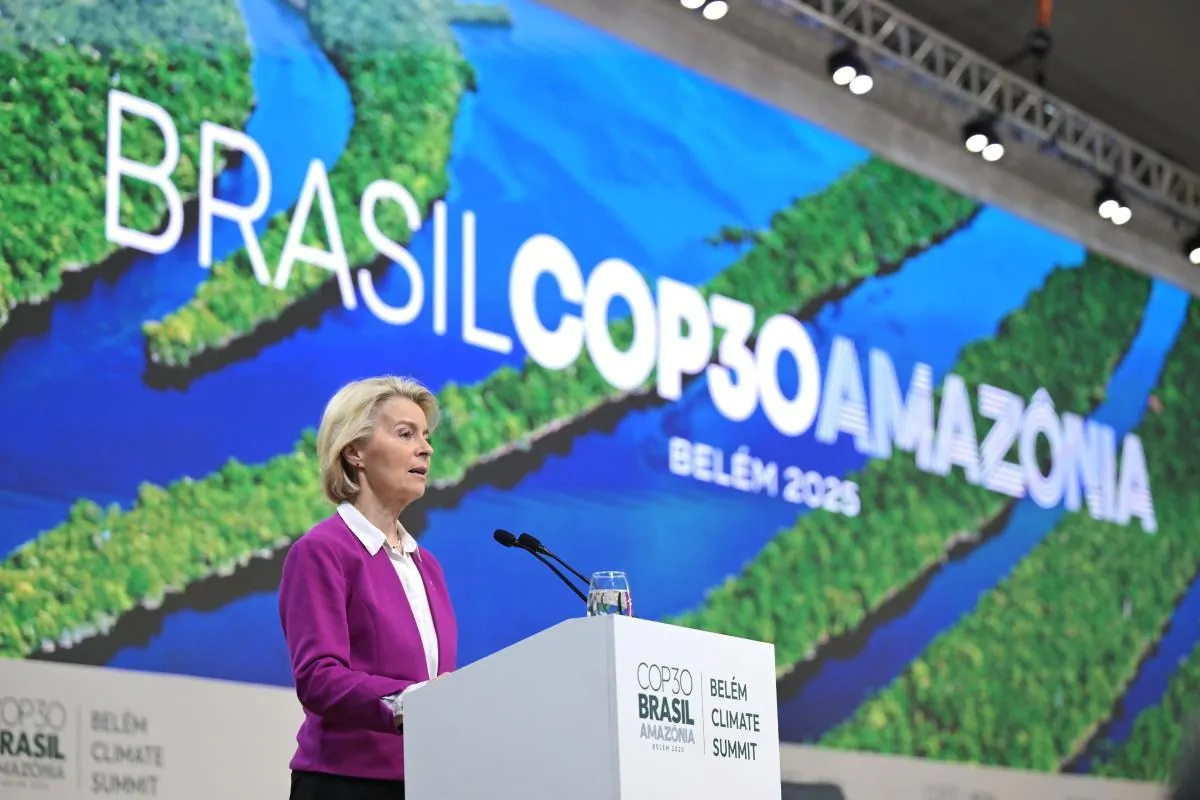In the week leading up to COP30 in Belém, Brazil, Europe sent a mixed and rather uncomfortable message to the world. On paper, the EU reaffirms its commitment to climate neutrality by 2050. In practice, it has now agreed to a 90% reduction in greenhouse gas emissions by 2040, compared with 1990 levels, surrounded by a web of flexibility clauses, offset mechanisms and review options.
The 27 EU governments endorsed the European Commission’s proposal but included:
- “Flexibility” mechanisms and compensatory loopholes.
- The option to revisit the target every five years, especially if energy costs rise or the economic outlook worsens.
Scientists and NGOs warn that this compromise may well undermine the credibility of the 2050 net zero goal. As Ottmar Edenhofer, Chair of the European Scientific Advisory Board on Climate Change, bluntly put it:
“It is a political compromise that keeps the target alive, but raises the risk of failure.”
For ESG professionals, this is not a distant policy debate. It affects:
- Transition plans and climate strategies.
- Risk assessments and materiality analyses.
- Supply chain decisions, capital allocation and industrial policy.
Understanding this new 2040 landscape – especially in the context of COP30 – is now essential if you are responsible for ESG reporting, strategy or risk in Europe.
Benefits of Understanding the 2040 Target for Your ESG Work
Grasping the details and tensions behind Europe’s 2040 target gives you several concrete advantages in your role:
- Clearer ESG Strategy and Climate Roadmaps
You can connect the European Climate Law, the 2040 target and the 2050 neutrality objective to your organisation’s own emissions pathway, digital roadmaps and investment priorities. - Better Interpretation of “Loopholes” and Offsets
The new framework allows only 85% of reductions to be achieved inside the EU, with the remaining 5% potentially financed through international carbon markets, mostly in the Global South. You will be able to explain the risks of excessive dependence on carbon credits, including accusations of burden-shifting and greenwashing. - Alignment with CSRD, ESRS and Climate Disclosure
As Europe updates its Nationally Determined Contribution (NDC) and refines targets, you will be better placed to align reporting under CSRD and ESRS with EU climate policies, including transition plans, resilience analysis and funding mechanisms such as Global Gateway. - Stronger Dialogue with Leadership and Boards
You can brief executives on how current choices – such as relying on offsets, slowing down internal decarbonisation or resisting regulation – may damage long-term competitiveness in sectors like automotive, energy, and manufacturing. - Career Growth in a Tightening Policy Environment
As NGOs, investors and regulators increase scrutiny, professionals who can bridge climate science, EU policy and ESG practice will be in high demand. A European-focused ESG certification becomes a powerful differentiator.
Environmental organisations, including Carbon Market Watch, describe the new deal as a “dangerous backslide” filled with “accounting tricks” that shift responsibility to vulnerable partners in the Global South. Its Executive Director, Sabine Frank, argues that European governments:
“are showing a lack of courage and strategic vision. Instead of investing in domestic solutions, they are buying time and outsourcing responsibility.”
Being able to interpret such critiques and translate them into robust strategies and disclosures is now a key professional skill.
Practical Steps for ESG Professionals Responding to Europe’s 2040 Pathway
- Decode the “Flexibility” – and Its Risks
The European Climate Law (2021) sets legally binding goals:
- At least 55% emissions reduction by 2030.
- Climate neutrality by 2050.
The new 2040 target is meant to bridge the gap and balance concerns about competitiveness. The Danish Presidency called it “a balance between the green transition and economic resilience”. Yet the political and scientific debate highlights several risks:
- Overuse of international carbon credits instead of domestic decarbonisation.
- Repeated five-year reviews that could delay or dilute action.
- Pressure from Member States (such as Hungary, Poland and Slovakia) who cite social and energy impacts to resist tougher action.
As an ESG practitioner, you should:
- Identify where your organisation may be relying on the same “flexibility reflex” – postponing real action while talking up long-term goals.
- Ensure your climate targets go beyond the minimum and are science-based, not just policy-compliant.
- Integrate Physical and Transition Risks
Environmental NGOs remind policymakers that delays already carry a high price:
- Floods, heatwaves and droughts are impacting agriculture, transport and public health.
- Economic stability is threatened by escalating climate-related disasters.
In your risk assessments and double materiality analysis, factor in:
- Physical risks to assets, supply chains and communities.
- Transition risks linked to policy tightening, carbon pricing and evolving trade rules (for example, tariffs and carbon border measures).
- Use COP30 and EU Finance as a Strategic Lever
Ahead of COP30, Commission President Ursula von der Leyen emphasised that this must be the summit that keeps 1.5°C “alive”, triples renewables and doubles energy efficiency by 2030. She highlighted that:
- The EU provided over 34 billion USD in public climate finance in 2024.
- Through Global Gateway, the EU is driving dozens of bilateral green deals, supporting investment, jobs and sustainable development worldwide.
For ESG teams, this opens opportunities to:
- Align corporate plans with EU climate finance and partnership frameworks.
- Position projects to benefit from EU-supported investment, especially in green infrastructure, energy and supply chains.
- Follow the Brussels Timeline that Will Shape Your Work
The climate and industrial strategy debate continues in Brussels, with a critical December ahead. Key upcoming milestones include:
- Monday, 10 November – The ENVI Committee is expected to adopt its position on the 2040 emissions reduction target. This is a decisive step for the future of the European Green Deal.
- Wednesday, 12 November – Debate in the European Parliament on the new Multiannual Financial Framework (MFF 2028–2034), including spending limits and funding for the green transition.
- Thursday, 13 November – Vote on the Sustainability Simplification Package, which aims to reduce bureaucracy without lowering environmental and social standards.
Monitoring these developments will help you anticipate new obligations and opportunities in funding, regulation and stakeholder expectations.
- Invest in Targeted, European-Focused ESG Training
To turn this complex picture into action, many professionals now seek structured guidance. The Europe | Certified Sustainability (ESG) Practitioner Program, Advanced Edition 2025 provides exactly that, with:
- A strong focus on European climate and ESG legislation.
- Practical tools for CSRD, ESRS, GRI, SASB, TCFD and emerging standards.
- Real case studies on net zero, Scope 3, supply chains, climate risk and greenwashing.
Common Mistakes to Avoid in the New 2040–2050 Landscape
Even well-intentioned organisations fall into predictable traps when targets and policy frameworks shift:
- Seeing 2040 and 2050 as distant issues and failing to translate them into short-term, sector-specific actions.
- Assuming offsets are always acceptable, rather than prioritising deep decarbonisation.
- Ignoring industrial and geopolitical factors, such as competition with China and the US, supply-chain concentration and energy dependency.
- Treating ESG as a reporting exercise only, instead of a core component of competitiveness and security.
Robust ESG training helps you spot and address these pitfalls early, so that your organisation does not end up “buying time” instead of building resilience.
Real-World Applications: Climate, Competitiveness and Security in Europe
Europe’s climate debate is now deeply entwined with industrial policy and geopolitics. Understanding this context is vital for anyone shaping ESG strategy.
The Automotive Sector: Green Transition Meets Industrial Pressure
The European automotive industry shows how climate policy and competitiveness are inseparable:
- It represents around 7% of EU GDP.
- It employs more than 13 million people.
The sector faces intense pressure:
- China is flooding global markets with subsidised, low-cost EVs.
- The United States is imposing tariffs on European exports.
- Internal delays in shifting to mass, affordable EV production have weakened Europe’s position.
In 2024, Germany and France saw a fall in EV sales due to a focus on premium models. In 2025, once more affordable models were launched, sales increased by around 30%. The lesson for ESG and strategy teams is clear:
The demand for clean solutions exists – but pricing, accessibility and policy design must align.
Meanwhile, Chinese companies already hold nearly 10% of the European EV market, and plug-in hybrids are growing fast because they are not currently covered by new tariffs. At the same time, European brands have lost ground in China, with market share falling from 24% in 2020 to just 15% today. As Politico notes, protecting short-term profits cannot come at the expense of tomorrow’s industrial power.
China’s “Made in China 2025” vs Europe’s Strategy Gap
China’s “Made in China 2025” plan set clear, ambitious targets:
- 80% domestic production of renewable energy and EV technologies.
- Creation of global champions in batteries and electric mobility.
Europe, by contrast, has often lacked a coherent industrial strategy. The Commission’s initiative for affordable e-cars is a step in the right direction, but analysts warn that reacting only to short-term pressures will not win the competition with China – it will concede it.
For ESG professionals, this means integrating questions such as:
- Where do our critical technologies and materials come from?
- How resilient are our supply chains to policy and trade shocks?
- Are we investing early enough in innovation and skills?
The New EU Budget and Green Deal 2.0
Between 2026 and 2027, the EU will negotiate the new MFF 2028–2034. This budget will shape:
- The next phase of the European Green Deal (Green Deal 2.0).
- The Competitiveness Fund.
- Investments in clean technologies and just transition mechanisms.
The political divide is already clear:
- The “frugals” (Germany, Austria, the Netherlands and others) call for strict spending limits.
- The “friends of cohesion” (Spain, Portugal, Poland and others) push for more resources for regions and green investment.
Without a workable compromise, the climate transition could stall before it fully accelerates. The European Council on Foreign Relations warns that “inaction will cost more than investment” – a message ESG teams should reflect in their internal business cases.
Green Transition as a Security Strategy
The 2022 energy crisis showed that moving away from Russian gas is not only about climate policy; it is also about national and European security. Investments in:
- Renewables,
- Energy grids, and
- Clean industry
strengthen both resilience and strategic autonomy.
A new European identity is emerging, based on three pillars:
- Climate responsibility,
- Energy independence,
- Technological leadership.
The EU can continue to lead global climate action, but only if it delivers on credible interim targets rather than diluting them. For ESG professionals, this means designing strategies that align climate, industrial and security objectives, not treating them as separate agendas.
The Europe | Certified Sustainability (ESG) Practitioner Program, Advanced Edition 2025 dives into exactly these intersections, linking EU climate policy with ESG strategy, reporting and risk.
FAQs
What is Europe’s 2040 climate target in simple terms?
Europe aims to cut its greenhouse gas emissions by 90% by 2040, compared with 1990 levels, while still targeting climate neutrality by 2050. Around 85% of reductions must be achieved within the EU, with up to 5% allowed through international carbon credits, which is why many observers worry about loopholes and delayed action.
How long does it take to learn ESG in the European context and get certified?
If you already work in sustainability, finance, risk or corporate strategy, you can build strong foundations in a matter of weeks rather than years, provided the training is focused and practical. The Europe | Certified Sustainability (ESG) Practitioner Program, Advanced Edition 2025 combines live sessions and self-paced learning over roughly eight weeks, including project work and optional specialisation modules.
Is ESG training worth it for career growth in Europe right now?
Yes. As Europe tightens climate and sustainability regulations, organisations urgently need professionals who understand both EU policy and practical ESG implementation. A recognised, European-focused ESG certification strengthens your credibility with employers, clients and investors, and supports career progression in sustainability, finance, consulting, supply chain and corporate leadership roles.
Join the Europe ESG Practitioner Program
Europe enters COP30 and the next decade of climate action with ambitious long-term promises and contested interim targets. The direction is clear: more climate ambition, more scrutiny, and a closer link between ESG, competitiveness and security.
The real question is whether organisations – and the people leading their ESG work – are ready.
If you want to:
- Understand how Europe’s 2040 and 2050 climate goals will shape regulation, markets and supply chains.
- Design credible transition plans, materiality analyses and sustainability strategy.
- Strengthen your ESG reporting under CSRD, ESRS, GRI, SASB and TCFD.
- Gain a recognised certification that reflects European realities and global best practice,
then now is the right moment to invest in your skills.
Register for the upcoming Europe | Certified Sustainability (ESG) Practitioner Program, Advanced Edition 2025 and equip yourself to lead in Europe’s evolving climate and ESG landscape.







